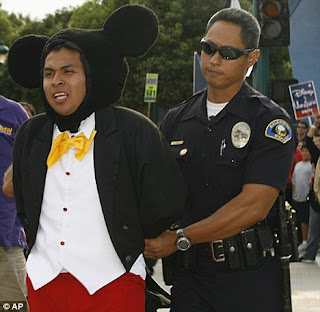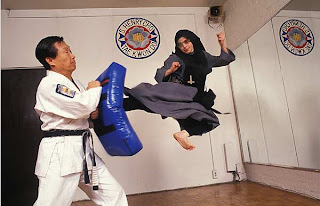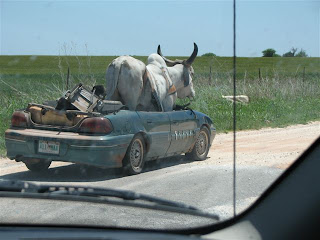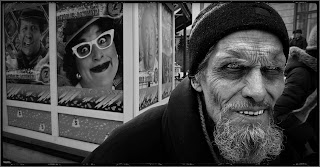Wednesday, February 11, 2009
Swing your parter round and round...
Tuesday, October 28, 2008
Congratulations, Graham and Keith!
Graham Raubvogel co-directed The First Supper, which won the Best Short award, and Keith LaFountaine got an Honorable Mention for the film he made last year at Edmunds Middle School, If You Can't Say Anything Nice.
It's worth noting that Graham and Keith were the only two high school students competing in an otherwise all-college film student competition. Congratulations, Graham and Keith! Keep up the good work!
Friday, October 17, 2008
How to make a documentary film
So only half of my intro to filmmaking class showed up last night and it was the week I was to introduce their documentary filmmaking assignment. I went over the process for making a documentary film that I wanted them to use in class, but because so many students were absent, I wound up writing it all down as a step-by-step process in an email to them. So I figured, as long as I’m typing it out, I might as well share it broadly.
This is by no means how every doc filmmaker makes films — I don’t even follow these steps exactly in my own filmmaking — but it’s a good process that works and is easy to follow for first-timers. Were I to write a longer piece or a book on this, I would include tips about getting good picture and audio and on conducting interviews and on different doc forms and techniques.
This process assumes that the filmmaker has access to a digital video camera and a computer-based editing system. It further assumes the doc you’re making is interview-based. Many documentaries contain no interviews at all. This may not be a very useful process for those films.
- RESEARCH - What do you think the story is? What’s the conflict? Who is the main character? Who is the audience for your film? Conduct pre-interviews by phone with potential subjects. Who will you interview on camera? What other visuals or archival materials do you have (photos, video, film, documents, etc.)? If you’re making an argumentative piece, try to understand all sides of the issue as best you can.
- SHOOT INITIAL INTERVIEWS - Get your main subjects talking on-camera. Make sure they answer in complete sentences — get them to say the things you want in the way you want them to. Don’t be afraid to ask them to rephrase their answers. Make sure the audio is clean and get all subjects to sign a release (MS Word doc)! Shoot targets of opportunity as you interview the subjects. If you’re interviewing an academic expert, get shots of the degrees on his/her office wall, items on the desk, etc. Does the subject mention items nearby that are easy to shoot? Don’t make yourself have to come back later to pick up missed shots. Also, allow yourself to follow unexpected paths. You may have started out wanting to make a film about an upcoming city council vote, but if you discover evidence of government corruption in your research and interviews, be willing to change the focus of your film.
- TRANSCRIBE YOUR INTERVIEWS - Type, type, type. Include timecode information on your transcripts so the words relate to their location on the tape(s). On average, you want at least 3 or 4 references to the TC on each single-spaced page of transcribed interviews. I like to use a two-column table in MS Word with the first column containing the TC and interview questions and the second (larger) column containing the text of the responses.
- MAKE A “PAPER EDIT” - sit down with your transcriptions (and a highlighter and a hot cup of cocoa) and select the quotes that support the story you want to tell, then arrange them in the order that best tells that story. You can literally cut them out and arrange them on the floor or you can copy and paste them — but remember to keep the TC info handy for each bit you use. This is how you make the skeleton of your film.
- CAPTURE YOUR INTERVIEW FOOTAGE - Focus on capturing the selected parts from your paper edit using the timecode info you wrote down with your transcriptions.
- EDIT A ROUGH CUT - Edit together your interview footage in skeletal form, making sure the audio of the interviews is clean and sounds natural — don’t worry about the picture yet. There will be some ugly cuts in your footage that you’re going to cover up with the footage you shoot in the next step. As you edit, consider the form of the finished film. Will you include voice-over narration, titles, music? What’s your hook? Are you using narrative techniques like reveals? How will the pacing work? Feel free to include placeholders for footage you have not acquired yet — usually blank frames with text describing what will go there eventually.
- SHOOT “B-ROLL” - Listen to the what the interview subjects are talking about and make a list of “b-roll” footage to go out and shoot. If your subject is talking about the shop where she/he works, go shoot the outside of the shop (an establishing shot) and some footage of the subject doing his/her job. B-roll footage will make up a significant amount of your doc, so shoot lots of it! Make sure it relates to the things your subjects are talking about in the rough edit you made. NOTE: it’s important to shoot your b-roll AFTER you make your rough cut. Before the rough cut, you don’t know which interview bits you’ll use and you may wind up shooting b-roll that is irrelevant to your film.
- GATHER YOUR ARCHIVALS - Shoot other targets of opportunity and gather your archival materials. Is your film about an event? Go shoot footage of the event. Are you making a film about the history of zombie culture in VT? Make sure you shoot the Church St. zombie walk tomorrow! Scan any photos or documents that may be relevant. If your subject talks about scoring the winning goal in his high school hockey championship game, does he have a photo of his team? Is there video of the game? You get the idea. Gathering these items can happen at any point in the doc-making process.
- EDIT! - Assemble your film. Remember you’re telling a story just like in fictional narrative films. What’s your hook? Where is the conflict? Who are the main characters? Always ask yourself these questions. Does your film succeed at the goals you had when you began making it?
Tuesday, October 14, 2008
Voluneers needed for film festival!

The Vermont International Film Festival runs from Oct. 23 - 26. They need volunteers to help run the show. They are offering free passes to films and the respect and admiration of the film-going community in exchange. Consider becoming a VIFF volunteer and contact Bridget Meyer for more info. Her email address is bmeyer1038 at aol dot com.
Sunday, October 12, 2008
In or Out?
Thursday, October 9, 2008
Ark

Friday, September 19, 2008
Welcome BHS students!
Any BHS students coming here for the first time, this blog is also a resource for the intro to filmmaking class I'm teaching at CCV this semester. BHS students, meet the CCV students -- CCV students, meet the BHS students! Feel free to introduce yourselves in the comments.
-Bill
DIY filmmaking tutorials: rule of thirds
Framing and Composition from Videopia on Vimeo.
Tuesday, September 16, 2008
inspiration.
So how do we come up with good ideas that are worth telling? How does one even begin to think of a story? Sometimes we just need a little push. Below I'm posting some images I found online. I'm posting them without comment. Maybe they'll spark some creative ideas for you. Maybe they will give you ideas for shots.
What's your idea?





Thursday, September 4, 2008
September!
To get us all in the right mood, here is a video featuring This American Life producer, Ira Glass, discussing storytelling in media. Whether you're a veteran movie maker or just starting out, this is inspiring stuff. Check it out...